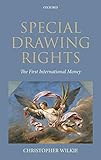Special drawing rights (SDRs) : the first international money / by Christopher Wilkie.
Material type: TextPublication details: Oxford ; New York : Oxford University Press, 2012. ISBN: 9780199606467 (hbk.); 0199606463 (hbk.)Subject(s): International Monetary Fund -- History | Special drawing rights -- History | United States -- Foreign economic relationsDDC classification: - Online resources: Full text through SAU LAN | DOI : Full text through SAU LAN
TextPublication details: Oxford ; New York : Oxford University Press, 2012. ISBN: 9780199606467 (hbk.); 0199606463 (hbk.)Subject(s): International Monetary Fund -- History | Special drawing rights -- History | United States -- Foreign economic relationsDDC classification: - Online resources: Full text through SAU LAN | DOI : Full text through SAU LAN
Oxford scholarship online Economics and Finance
Includes bibliographical references (p. [263]-286) and index.
Introduction -- The genesis of SDRs and the limitations of the Rio agreement -- SDRs in the transition from Bretton Woods monetary arrangements -- The influence of US and European policy on the SDR under post-Bretton Woods arrangements -- The SDR and the US international monetary policy process -- SDRs and the negotiation of the second amendment to the fund's articles of agreement -- SDRs after the second amendment -- Conclusion.
"Following the Rio Agreement in 1967, the birth of the Special Drawing Right (SDR) was widely heralded as the first step towards a world international money. The SDR's intended purpose, though, was more modest: to help salvage the prevailing international monetary system which had evolved since Bretton Woods. This volume examines the relatively recent and important history of SDRs--what they are, where they came from, and why they are significant. It considers the changing roles and influences of the U.S. and the IMF as post-Bretton Woods monetary arrangements established themselves. Despite their retreat from early acclaim, work continued, particularly at the Fund, on enhancing the potential of SDRs to contribute to international monetary stability and SDRs have recently re-emerged as a potential source of support and stability for the international monetary system underpinning the world economy. The SDR, and the debate surrounding it, is an excellent prism through which to examine other important themes in contemporary international political economy, including international liquidity provision and international monetary reform. Ultimately, the policies of the U.S., the Fund, and the changing nature of the relationship between them emerge as fundamental themes for an understanding of prospects for SDRs under post-Bretton Woods international monetary arrangements. Today, the promise and disappointment that has characterized the short history of SDRs is more important than ever as the world again examines these arrangements in the wake of the international financial crisis."--Publisher's website.
roy


There are no comments on this title.